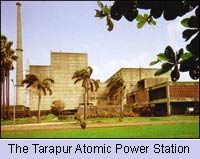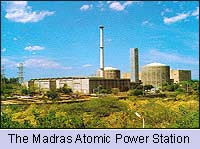| HOME | NEWS | SPECIALS | ||||


|
||||||||
|
Part 2
A Chernobyl can happen in India anytimeGeorge Iype
An explosion in Trombay rocks the city. Tremors are felt at the Bombay Stock Exchange, the city's financial hub, some 25km away. Minutes later a ball of fire engulfs parts of Bombay. The wind whips it about. Pedestrians fall down. The sea swells angrily. There is chaos like never before... This reads very much like the nuclear apocalypse that Humphrey Hawksley describes in Dragon Fire. But it can come true. A Chernobyl-type accident can take place at India's nuclear power plants. Anytime. The threat is real because India is the only country in the world where nuclear research and plutonium production occur near crowded areas. Some reactors operate beyond danger levels. For instance, the emergency cooling system at the atomic power plants in Madras and Rajasthan are inadequate. The reactors in Tarapur are outmoded and, according to experts, should be closed down immediately. The country's first nuclear power plant, the Tarapur Atomic Power Station, has two reactors -- TAPS 1 and 2. These were constructed with technical assistance from the United States in 1969. Nowhere in the world do such outmoded reactors function. Adequate cooling systems and tube failures have forced the authorities to lower the load on the TAPS reactors from 210 MW to 160 MW. They have also discontinued the use of nitrogen to make the containment safe. With such blatant violations of safety norms, experts warn the reactors could melt down and explode anytime. For proof, look at what happened at Narora in 1993. The Narora Atomic Power Station was commissioned in 1991. But the failure of two steam turbine blades resulted in a major fire in one of the heavy water reactors, which nearly led to a nuclear meltdown. The US-based General Electric, the manufacturers of the turbines, had warned about the problem and offered a revised design. But neither the government nor the Department of Atomic Energy found it prudent to effect these changes. LIKE Tarapur and Narora, the other nuclear power reactors across the country have dangerous flaws. Which is why experts say that nuclear accidents like those at Chernobyl in Russia in 1986 and at Tokaimura in Japan should be lessons for India's nuclear establishment. "There could be lesser accidents which could still release moderate amounts of radioactivity into the crowded areas surrounding some of our less-safe installations at Madras, Trombay or Tarapur. It could be devastating to a large number of people," says Dr A Gopalakrishnan, former chairman of the Atomic Energy Regulatory Board. For instance, says Dr Gopalakrishnan, the Madras Atomic Power Station reactors at Kalpakam, situated just outside the city, are operated without proper emergency cooling systems. For their part, the authorities claim that Indian nuclear power plants abide by international regulations on radioactive emissions and safety standards. The debate today is whether India should promote nuclear energy production when the rest of the world is closing down reactors in view of safety and environmental concerns. According to S P Udayakumar, research associate and co-director of programmes at the Institute on Race and Poverty, University of Minnesota in the United States the stress has now shifted from nuclear power plants. For instance, Commonwealth Edison, the largest private operator of nuclear plants in the US, has just announced the closure of two of its plants in Zion, Illinois, because of economic reasons. The company's Quad Cities plant near Molline, Illinois, was shut down late last year due to safety concerns. Only four of the company's 12 plants currently generate electricity. Northeast Utilities, another nuclear generator that owns three nuclear plants at Waterford, Connecticut, also recently suspended the efforts to reopen its oldest unit. "If cost considerations and safety concerns oblige the wealthy and highly advanced American nuclear industry, one can imagine the predicaments India could face on both these fronts," says Udayakumar. IN India, the nuclear power industry faces the problem of storing spent fuel. The threat to life and environment too is great.
It contained 134 safety suggestions and was accepted by the Atomic Energy Commission, which passed it on to the DAE for corrective steps. The report, which is still a classified document, had identified many serious deficiencies in our initial installations, the plants that were set up in 1979 and 1987 by the DAE. Shockingly, these deficiencies are yet to be rectified. According to Dr Gopalakrishnan, the 1995 report find the safety levels in some of India's installations well below the international norms. "The DAE is postponing the repairs because of several reasons. In some cases, it will necessitate very long shutdown of a facility. In certain others, spare parts and equipment are denied to India," he says. DESPITE such concerns, NPCIL officials say India has a very good safety record. They rule out a Chernobyl anywhere in India. "The Chernobyl accident occurred due to the negligence of operators who violated safety procedures," says NPCIL Chairman and Managing Director V K Chaturvedi. "Besides, the reactor was a totally different type. It employed graphite as a moderator. Graphite is a form of carbon and its combustible property contributed to explosion in the reactor core. "In our nuclear plants explosion in the core is ruled out as it is cooled and moderated," he adds. He is of the opinion that the safety features in India are adequate. "We have given paramount importance to the safety of the staff, public and environment. Safety experts and regulatory personnel are associated at all operations of nuclear power plants," he says. Chaturvedi may be confident, but there are many other experts who are not. They warn that explosions and meltdowns are waiting to happen in our plants. And then, they say, the Indian nuclear establishment's confidence of being "the bomb-maker" will not help.
ON TO PART 3
Page design: Dominic Xavier
|
|||||||
 Bombay, India. 1430 hours, Thursday, April 14, 2001.
Bombay, India. 1430 hours, Thursday, April 14, 2001.
 It is not that India is not addressing the safety concerns. After the
Narora accident in 1993, the government entrusted the AERB to study the
issue. In 1995, the AERB, then headed by Dr Gopalakrishnan, produced a
secret report, Safety issues in DEA installations.
It is not that India is not addressing the safety concerns. After the
Narora accident in 1993, the government entrusted the AERB to study the
issue. In 1995, the AERB, then headed by Dr Gopalakrishnan, produced a
secret report, Safety issues in DEA installations.
